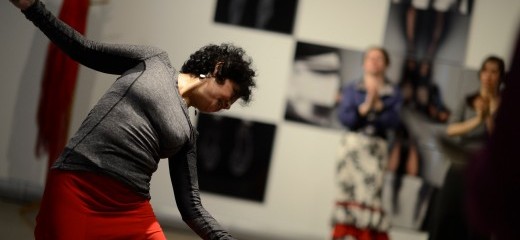
Photo: © Jacques-Jean Tiziou / www.jjtiziou.net
Passionate Precision
by Lynn Matluck Brooks
Flamenco evolved in intimate environments—back-street cafés, the caves of Granada, someone’s kitchen or patio—certainly site-specific, in their ways. The form’s complex of elements—spoken or sung word, guitar and rhythmic clapping, footwork-driven dancing, and the focused engagement of everyone else in the space—infused flamenco with enthralling power. A taste of that intimacy came to Drexel University’s Leonard Pearlstein Gallery with Cosas de Mujeres (Things of Women) presented by Pasión y Arte Flamenco. Elba Hevia y Vaca, the company’s director and choreographer, brought together a remarkable line-up of artists.
The setting for the performance was the exhibition, “Ray Bartkus: Storylines,” which featured gigantic paintings of heads, feet and torsos, each metal-encased and sometimes connected by metallic struts to other works, structuring the gallery’s L-shaped space. The dance program’s seven sections, a suite of traditional flamenco rhythms that expressed a range of moods and tempi, featured different combinations of artists leading us throughout the gallery. As Bartkus’s work draws the viewer’s attention to the body itself as art subject, so does dance, although Hevia y Vaca approached the installation for the purpose of architectural framing, not for locating specific expressive parallels between painted and dancing bodies.
The bulerías that opened the evening, near the gallery’s entrance, introduced us to the guitar of Ricardo Diaz, the percussion of Francisco Zayas and the singing of Barbara Martinez. The electric conversation among these distinctively refined voices interwove with the dancers’ rhythms to create the concentrated energy that makes flamenco an explosively exciting art. For the tarantos, second on the program, the performers flowed through the audience in order to lead us to the gallery space on the other side of the entranceway. There, dancer Amilia Hernandez drew me into her dramatic reaches as she folded the space into herself, then sent it outward to us. Blocked by audience members standing in front of me, I had no view of the dancer’s feet, but could appreciate what I heard of their rhythmic riffs.
Tangos brought the performers a bit deeper into the gallery, where Hernandez, Hevia y Vaca, and dancers Alexa Miton and KC Chun-Manning (a modern dancer)—all seated on low stools—playfully manipulated fans to hide and reveal their faces as Ines Arribas chanted poetry that brought to mind children’s word-games. The mood became more serious as Miton and the musicians positioned themselves inside a steel-bounded rectangle of space where the dancer’s impassioned soleá por bulerías enwrapped her in a brilliant red shawl from which she emerged to flash sparks of lightning footwork and stunning stillnesses. Miton’s rhythmic brilliance and the tight musical ensemble made this a highpoint of the show.
After this powerhouse performance, the audience followed the troupe further into the gallery for a cheerful, folk-like tanguillos danced by Miton and Hernandez, circling one another, slapping their ankles, smiling and enjoying lighthearted exchanges. The mood shifted again as Hevia y Vaca and Miton donned batas de cola (long-trained ruffled skirts) for alegrías in two distinct moods. Hevia y Vaca bent her torso deeply, then stretched hungrily into the space, employing the skirt as a shield, a cape, a cover-up, and even a burden to bear. Miton, on the other hand, clearly enjoyed showing her virtuosic one-legged spins, sweeping the bata, kicking it from side to side, playing with its weight and momentum.
The final section, a
seguiriyas, brought Chun-Manning and Hernandez into yet a different part of the gallery, creating the evening’s most successful integration of the accomplished modern dancer into the world that the other performers comfortably inhabited. Here, Chun-Manning’s arm movements, postures, energies and encounters were met by Hernandez’s to make a comprehensible connection, rather than a sometimes puzzling contrast; in other parts of the evening, Chun-Manning’s movement contributions seemed self-conscious and extraneous to the tightly-knit flamenco community she seemed to have mysteriously landed in. During a spoken-word interlude preceding the
tanguillos, she herself voiced the question, “Why am I here?” I suspect her presence was intended as an objectifying technique to invite the viewer to see current flamenco dance in light of another contemporary movement style. Hevia y Vaca has explored this fascinating concept
elsewhere, but only in this last section of
Cosas de Mujeres did this show’s pairing of styles move past awkward juxtapositions to a meaningful exchange. Perhaps because Chun-Manning and Hernandez have, according to the brief program bios, studied and danced with some of the same contemporary dance artists, their movements meshed with a sensitivity that shared aesthetic roots make possible.
I have watched Hevia y Vaca’s artistry embolden Philadelphia’s dance world for over a decade. Her vision of flamenco as an art form for today has drawn my attention; in fact, she teaches an annual course at the college where I direct the dance program. Pasión y Arte Flamenco is among the most interesting, visionary companies brightening the city’s art scene, not only through Hevia y Vaca’s own choreography and performance, but through the artists with whom she collaborates and the vistas she broaches.
Cosas de Mujeres, Pasión y Arte Flamenco, Leonard Pearlstein Gallery of Drexel University, April 10-12.
By Lynn Matluck Brooks
April 14, 2015

